View in other NatureServe Network Field Guides
NatureServe
Montana
Utah
Wyoming
Idaho
Wisconsin
British Columbia
South Carolina
Yukon
California
New York
Green Fool Grasshopper - Acrolophitus hirtipes
General Description
The following was taken from Hebard (1928), Brooks (1958), Helfer (1971), Otte (1981), Capinera and Sechrist (1982), Vickery and Kevan (1985), McDaniel (1987), Capinera et al. (2004), and Scott (2010). This is a medium to large pale green grasshopper. The pointed head, red antennae, and high semicircular crest on the top of the posterior two-thirds of the pronotum (thorax) are distinctive characters. The hind wing has a pale-yellow disc and a broad black band. The apical third of the wing is clear.
Phenology
Nymphs appear in March or April. Adults occur from June through August or early September (Capinera and Sechrist 1982, Capinera et al. 2004, Otte 1981, Scott 2010, and Vickery and Kevan 1985).
Diagnostic Characteristics
The following comes from Hebard (1928), Brooks (1958), Helfer (1971), Otte (1981), Capinera and Sechrist (1982), Vickery and Kevan (1985), McDaniel (1987), Capinera et al. (2004), and Scott (2010). The body length to the end of the wings is 25 to 42 mm in males and 32 to 51 mm in females. The legs are covered with fine hairs. The hind tibia is green.
This species could be confused for a band-winged grasshopper, family Oedipodinae. The banded hind wing is unusual among the slant-faced grasshoppers and suggests that it may be some form of behavioral flight signal for mating (Otte 1981).
Species Range
Montana Range
Range Descriptions
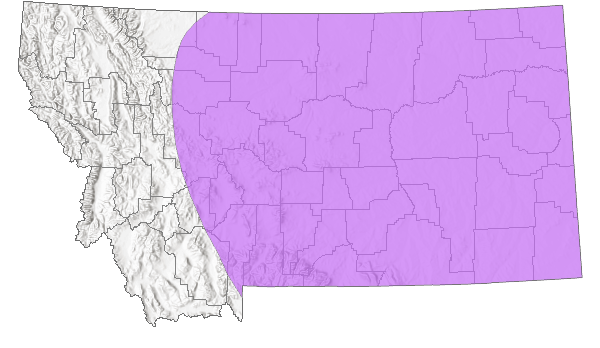
 Native
Native
Range Comments
Distributed across the Great Plains from southern Alberta and Saskatchewan south to Texas and northern Mexico, and from the western Dakotas, Nebraska, and Oklahoma, westward to the Rocky Mountain front range. In Montana, this species has been found in 20 counties (Capinera and Sechrist 1982, Capinera et al. 2004, Otte 1981, Scott 2010, and Vickery and Kevan 1985).
Observations in Montana Natural Heritage Program Database
Number of Observations: 8
(Click on the following maps and charts to see full sized version)
Map Help and Descriptions
Relative Density
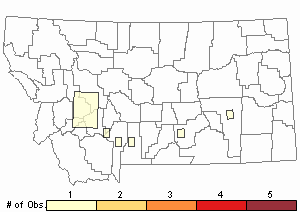
Recency
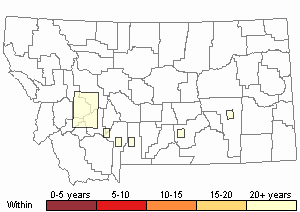
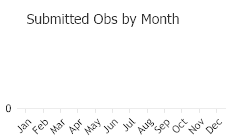
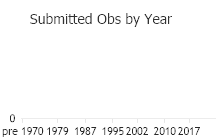
 (Observations spanning multiple months or years are excluded from time charts)
(Observations spanning multiple months or years are excluded from time charts)
Habitat
The Green Fool Grasshopper prefers rolling short-grass prairies with sparse vegetation, especially sandy areas (Capinera and Sechrist 1982, Capinera et al. 2004, and Otte 1981).
Food Habits
This species is unusual as being the only prairie slant-faced species that is a forb-feeder, preferring broadleaf species in the Borage family such as gromwell, stickseed, and cryptantha (Capinera and Sechrist 1982, Capinera et al. 2004, Otte 1981, and Vickery and Kevan 1985).
Reproductive Characteristics
The following is taken from Capinera and Sechrist (1982), Otte (1981), and Vickery and Kevan (1985). Males have been observed to stridulate (rubbing body parts together to produce sound) when courting females and in pair formation. The song consists of a series of “ticking” pulses which varies from twelve to eighteen. Females lay eggs just below the soil surface, which average about 6 eggs per pod in two columns of three. When nymphs hatch, they pass through 5 instars to adult stage. It has been suggested that eggs hatch in the fall and the nymphs are in the overwintering stage.
Stewardship Responsibility
References
- Literature Cited AboveLegend:
 View Online Publication
View Online Publication Brooks, A.R. 1958. Acridoidea of Southern Alberta, Saskatchewan, and Manitoba (Orthoptera). The Canadian Entomologist (Supplement 9) 90:5-92.
Brooks, A.R. 1958. Acridoidea of Southern Alberta, Saskatchewan, and Manitoba (Orthoptera). The Canadian Entomologist (Supplement 9) 90:5-92. Capinera, J.L. and T.S. Sechrist. 1982. Grasshoppers of Colorado: Identification, Biology, and Management. Fort Collins, CO: Colorado State University Experiment Station, Bulletin 584S. 161 p.
Capinera, J.L. and T.S. Sechrist. 1982. Grasshoppers of Colorado: Identification, Biology, and Management. Fort Collins, CO: Colorado State University Experiment Station, Bulletin 584S. 161 p. Capinera, J.L., R.D. Scott, and T.J. Walker. 2004. Field Guide to Grasshoppers, Katydids, and Crickets of the United States. Ithaca, NY. Cornell University Press.
Capinera, J.L., R.D. Scott, and T.J. Walker. 2004. Field Guide to Grasshoppers, Katydids, and Crickets of the United States. Ithaca, NY. Cornell University Press. Hebard, M. 1928. The Orthoptera of Montana. Proceedings of the Academy of Natural Sciences of Philadelphia, Vol. 80:211-306.
Hebard, M. 1928. The Orthoptera of Montana. Proceedings of the Academy of Natural Sciences of Philadelphia, Vol. 80:211-306. Helfer, J.R. 1971. How to Know the Grasshoppers, Crickets, Cockroaches, and Their Allies. Revised edition (out of print), Mineola, NY: Dover Publications.
Helfer, J.R. 1971. How to Know the Grasshoppers, Crickets, Cockroaches, and Their Allies. Revised edition (out of print), Mineola, NY: Dover Publications. McDaniel, B. 1987. Grasshoppers of South Dakota. Brookings, SD: South Dakota Agricultural Experiment Station, Bulletin TB 89.
McDaniel, B. 1987. Grasshoppers of South Dakota. Brookings, SD: South Dakota Agricultural Experiment Station, Bulletin TB 89. Scott, R.D. 2010. Montana Grasshoppers, Katydids, and Crickets A Pictorial Field Guide to the Orthoptera. MagpieMTGraphics, Billings, MT.
Scott, R.D. 2010. Montana Grasshoppers, Katydids, and Crickets A Pictorial Field Guide to the Orthoptera. MagpieMTGraphics, Billings, MT. Vickery, V. R. and D. K. M. Kevan. 1985. The grasshopper, crickets, and related insects of Canada and adjacent regions. Biosystematics Research Institute, Ottawa, Ontario. Publication Number 1777. 918 pp.
Vickery, V. R. and D. K. M. Kevan. 1985. The grasshopper, crickets, and related insects of Canada and adjacent regions. Biosystematics Research Institute, Ottawa, Ontario. Publication Number 1777. 918 pp.
- Additional ReferencesLegend:
 View Online Publication
View Online Publication
Do you know of a citation we're missing? Anderson, N.L. 1951. Field studies on the biology of range grasshoppers of southeastern Montana. M.Sc. Thesis. Bozeman, Montana: Montana State University. 96 p.
Anderson, N.L. 1951. Field studies on the biology of range grasshoppers of southeastern Montana. M.Sc. Thesis. Bozeman, Montana: Montana State University. 96 p. Anderson, N.L. 1962. Grasshopper-vegetation relationships on Montana grasslands. Ph.D Dissertation. Bozeman, Montana: Montana State University. 73 p.
Anderson, N.L. 1962. Grasshopper-vegetation relationships on Montana grasslands. Ph.D Dissertation. Bozeman, Montana: Montana State University. 73 p. Otte, Daniel. 1981. The North American Grasshoppers. Volume 1. Acrididae (Gomphocerinae and Acridinae). Harvard University Press. 275 pp.
Otte, Daniel. 1981. The North American Grasshoppers. Volume 1. Acrididae (Gomphocerinae and Acridinae). Harvard University Press. 275 pp. Skinner, K.F. 1995. Plant and grasshopper community composition: indicators & interactions across three spatial scales. M.Sc. Thesis. Bozeman, MT: Montana State University. 144 p.
Skinner, K.F. 1995. Plant and grasshopper community composition: indicators & interactions across three spatial scales. M.Sc. Thesis. Bozeman, MT: Montana State University. 144 p.
- Web Search Engines for Articles on "Green Fool Grasshopper"
- Additional Sources of Information Related to "Insects"





